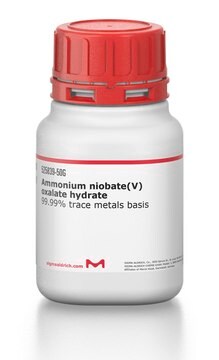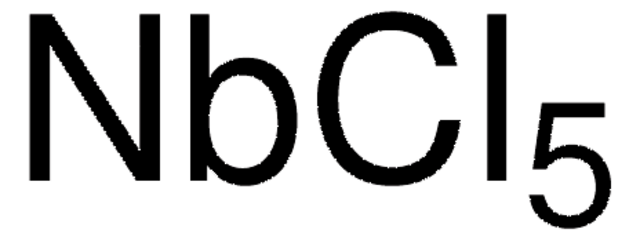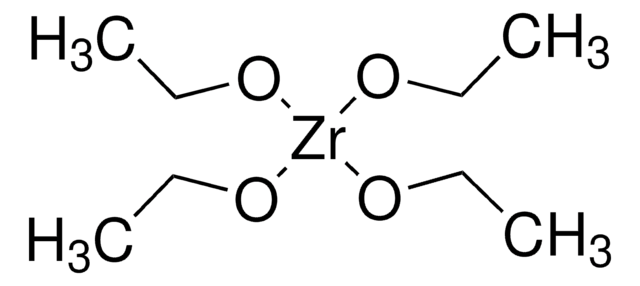339202
Niobium(V) ethoxide
99.95% trace metals basis
Sinónimos:
NbOEt, Niobium ethanolate, Niobium ethylate, Niobium pentaethoxide, Pentaethoxyniobium
About This Item
Productos recomendados
Quality Level
assay
99.95% trace metals basis
form
liquid
reaction suitability
core: niobium
refractive index
n20/D 1.516 (lit.)
bp
142 °C/0.1 mmHg (lit.)
mp
5-6 °C (lit.)
density
1.268 g/mL at 25 °C (lit.)
SMILES string
CCO[Nb](OCC)(OCC)(OCC)OCC
InChI
1S/5C2H5O.Nb/c5*1-2-3;/h5*2H2,1H3;/q5*-1;+5
InChI key
ZTILUDNICMILKJ-UHFFFAOYSA-N
¿Está buscando productos similares? Visita Guía de comparación de productos
General description
Application
Because of its low boiling point and low decomposition temperature (~325-350 °C),niobium(V) ethoxide is also used as a precursor in atomic-layer deposition, chemical vapor deposition, and metal-organic chemical vapor deposition of niobium oxides.
It can also be used as a dopant to prepare Nb-doped TiO2 photoanode for dye-sensitized solar cells (DSSC). The doping of Nb lowers the conduction band of TiO2 enhancing electron injection and transfer ability of TiO2 photoanode. This results in a significant increase in the performance of DSSC.
Features and Benefits
signalword
Warning
hcodes
Hazard Classifications
Flam. Liq. 3
Storage Class
3 - Flammable liquids
wgk_germany
WGK 3
flash_point_f
96.8 °F - closed cup
flash_point_c
36 °C - closed cup
ppe
Faceshields, Gloves, Goggles, type ABEK (EN14387) respirator filter
Elija entre una de las versiones más recientes:
¿Ya tiene este producto?
Encuentre la documentación para los productos que ha comprado recientemente en la Biblioteca de documentos.
Los clientes también vieron
Artículos
Thermoelectric Performance of Perovskite-type Oxide Materials
The prevailing strategies for heat and electric-power production that rely on fossil and fission fuels are having a negative impact on the environment and on our living conditions.
The properties of many devices are limited by the intrinsic properties of the materials that compose them.
Nuestro equipo de científicos tiene experiencia en todas las áreas de investigación: Ciencias de la vida, Ciencia de los materiales, Síntesis química, Cromatografía, Analítica y muchas otras.
Póngase en contacto con el Servicio técnico









